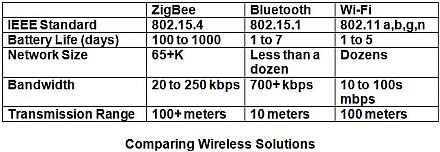
In the past, wireless network designers were most concerned about the area of physical coverage and bandwidth. The number of wireless devices supported was not an issue. The Internet of Things (IoT), however, changes everything. Where coverage was once the goal, now capacity, device population, and performance are the driving design goals.
The Internet of Things has either arrived or it is coming soon to your enterprise. Wireless network designers have been concerned in the past with area of physical coverage and bandwidth. The number of wireless devices supported wasn't an issue. However, the Internet of Things (IoT) changes everything. Where coverage area was once the goal, now capacity, device population, and performance are the driving design goals.
Defining IoT
The Internet of Things can describe a huge number and types of endpoints. Some endpoints can be passive, such as read only devices and sensors. Other endpoints can be active and report status, alarms, and alerts. Endpoints can also be used to control and change operations. The types of endpoints already in use can increase efficiency, reduce costs, and improve safety.
ABI Research estimates that there will be 30+ billion devices wirelessly connected to the Internet of Things by 2020. Cellular networks will support many of the portable/mobile IoT devices. There will be a huge population of fixed IoT endpoints that will need to communicate over short distance wireless networks.
- IoT applications include:
- Building automation
- Energy management
- Home automation
- Lighting control
- Healthcare
- Advanced remote controls
- Retail/shopping services
- Telecom services
Wireless Access Technology Choices
The Internet of Things is going to impact networks, and especially wireless networks, with access via Wi-Fi, ZigBee, and Bluetooth. Each of the candidate wireless technologies has its advantages and limitations. When Wi-Fi and Bluetooth emerged, the Internet of Things was mostly a concept. ZigBee was designed for a large population of low power, low bandwidth endpoints.
Wi-Fi - This is a LAN wireless technology that uses 2.4 GHz or 5 GHz radio. It is widely deployed in both enterprise and consumer locations. It is the implementation of the IEEE 802.11 standards, 802.11 a, b, g, n. Wi-Fi is best applied when sending large amounts of data wirelessly between devices. It is a large energy consumer. Many IoT endpoints only require a low level of data throughput. The bandwidth capabilities of Wi-Fi exceed the requirements for the majority of IoT endpoints. If the Wi-Fi endpoint runs with batteries, then the batteries have to recharged or replaced in days. Most Wi-Fi endpoints derive their power from PoE LAN switches, not batteries.
Bluetooth - Bluetooth technology was introduced by Ericsson about 20 years ago for personal data networks (PAN). A Bluetooth PAN transmits data over the frequency band between 2.4 and 2.485 GHz. It supports over shorter distances compared to Wi-Fi, and therefore can operate with less power. Devices can be paired together using Bluetooth including endpoints such as such as phones, smart-watches, headsets, speakers, and computers. Bluetooth v4.0 delivers the ability to implement low-energy features that conserve power. Version 4.2 introduces three low energy updates to the specification; data packet length extensions, privacy upgrades, and secure connections. Bluetooth is not a candidate for mesh networks.
ZigBee - ZigBee is a specification for a group of communication protocols used to create personal area networks (PAN) that support low-power digital radios. ZigBee is based on an IEEE 802.15 standard that specifies transmission distances to 10-100 meters using line-of-sight. The ZigBee endpoints are commonly run off of batteries that have a long life, i.e. months to years, because of the endpoints low power consumption.
The useful distance depends on power output and environmental characteristics. The lower two OSI layers are defined by the IEEE standard. The ZigBee Alliance embraces the middle four layers. The top application layer can be defined by the ZigBee Alliance or a vendor producing a proprietary solution. The drawback to ZigBee is that the number of different implementations make product interoperability problematic. ZigBee supports mesh networks.
Thread - This is a new comer to the IoT wireless network world. Thread is the product of an alliance between Nest, Samsung, ARM, and four other companies. The Thread Group plans to provide rigorous testing, certification, and standards enforcement. Existing Thread specifications would be able to support a network of up to 250 devices. Thread uses the same radio technologies as ZigBee from the IEEE standard 802.15.4. Thread supports mesh networks. Thread developers want to avoid what they see as the ZigBee problem of fractured standards by requiring a certification program or products. Look for its development; however,Thread is not yet a major candidate for IoT.
Comparing Wireless Choices
There are three common mature choices for connecting to wireless endpoints over short distances, generally 100 meters or less, Wi-Fi, ZigBee, and Bluetooth. The choice for IoT has to be able to support many endpoints in a limited area. The data produced by IoT endpoints in most cases is modest therefore the bandwidth required is also modest, kbps not mbps. The number of endpoints that can be supported by ZigBee is far greater than Wi-Fi and Bluetooth. Neither of these was designed for high density large endpoint populations.
Wi-Fi is best suited for desktop, laptops, tablets, and phones that require high data rates. Each of the added 802.11 standards has been directed at increasing bandwidth. Bluetooth was designed to deliver service on a desk connecting a wireless keyboard, mouse, printer, or headset. When the supported population is large and the area coverage is also large, then ZigBee becomes the preferred solution.
Processing IoT Data, Impact on the Networks
Collection of IoT data currently is typically centralized; for example, a data logger stores temperature and humidity of a shipment of vaccines during its journey. The analysis of that data must be centralized, especially as you move up the analytics maturity curve to gain operational intelligence from the data.
As sensor technology advances, we will start to see ecosystems where limited analytics will become decentralized. Some companies already offer endpoint controllers that process and digest IoT data for retail operations. Decentralized analysis will reduce the impact on the networks. There will be less traffic carrying less data-- data that is the result of decentralized analysis. Even then, for more advanced analytics, centralized processing will still be necessary.














Leave a comment